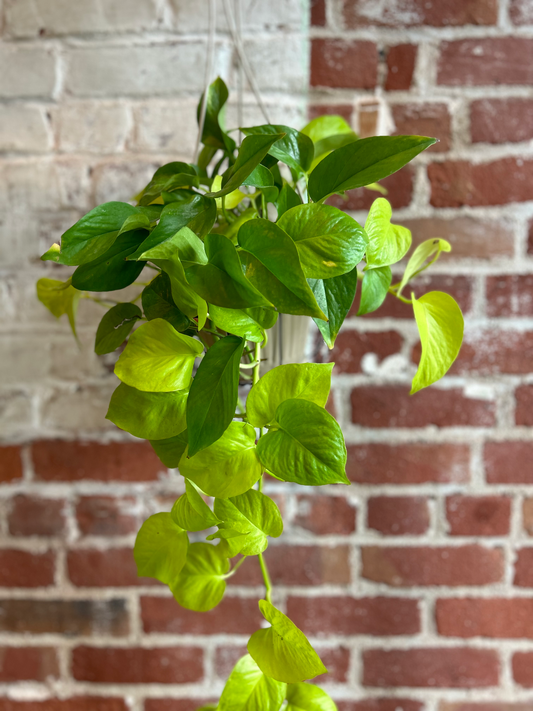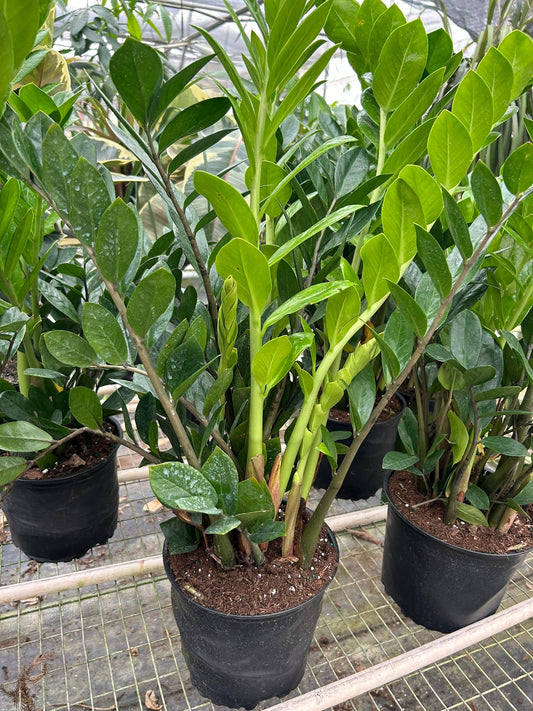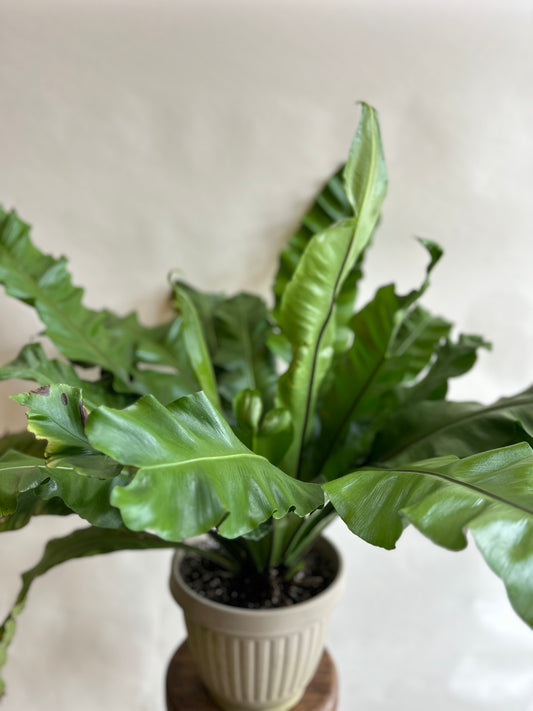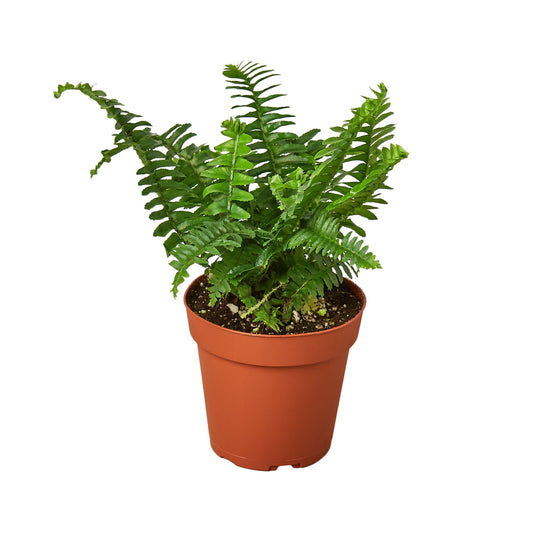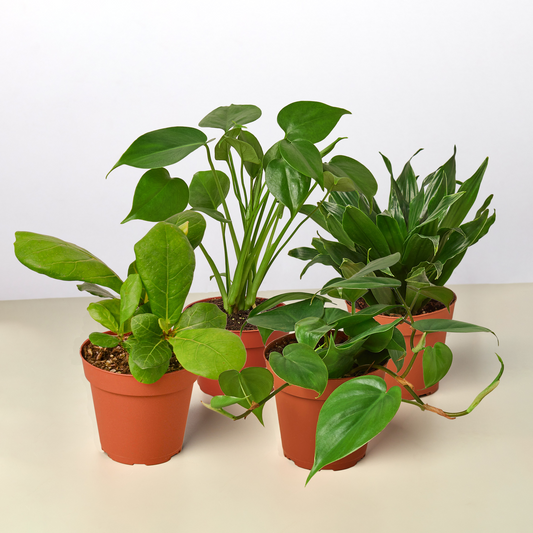How to Grow and Care for Queen Anthuriums
Cafe Planta Team
Have you ever stumbled upon a plant so striking that it seems to belong in an art gallery rather than your living room? Meet the Queen Anthurium, a plant that elevates any space with its royal presence and unique foliage. With its velvety leaves and dramatic size, this plant is a true showstopper in the world of houseplants.
In this article, we’ll go through everything you need to know about growing and caring for Queen Anthuriums. From understanding their ideal environment to tackling common problems, you'll find all the tips and tricks to ensure your plant not only survives but thrives. So, let’s get started on this leafy journey!
The Majesty of Queen Anthuriums
Queen Anthuriums, scientifically known as Anthurium warocqueanum, are tropical plants native to the rainforests of Colombia. These beauties are renowned for their long, narrow, velvety leaves that can grow up to a whopping three feet in length. The leaves feature prominent white veins, giving them an elegant, almost regal appearance.
What makes the Queen Anthurium a sought-after gem among plant lovers? Well, it’s not just about its looks. These plants bring a sense of tranquility and sophistication to any space. They’re perfect for those who appreciate a touch of the exotic in their home décor. Plus, the process of nurturing such a majestic plant can be incredibly rewarding.
However, with great beauty comes great responsibility. Queen Anthuriums require a bit more care and attention than your average houseplant. But don’t worry—once you understand their needs, you’ll find them just as easy to care for as any other plant in your collection.
Creating the Perfect Environment
To keep your Queen Anthurium happy, you’ll need to replicate its natural habitat as closely as possible. In the wild, these plants grow under the canopy of tropical forests, where they receive bright, indirect light and high humidity.
- Light: Avoid direct sunlight, as it can scorch their delicate leaves. Instead, find a spot where they can enjoy bright, filtered light. A north or east-facing window is usually ideal.
- Temperature: These plants prefer temperatures between 65-80°F (18-27°C). They’re not fond of the cold, so keep them away from drafts and sudden temperature changes.
- Humidity: High humidity is crucial. Aim for at least 60% humidity, which you can achieve with a humidifier or by placing a tray of water near the plant. Misting is also an option, but be cautious not to wet the leaves excessively.
Getting the environment right is the first step toward a thriving Queen Anthurium. It might take a bit of experimentation, but once you find the sweet spot, your plant will thank you with lush growth and vibrant foliage.
Potting and Soil Essentials
The right potting mix is another important factor in the care of Queen Anthuriums. They prefer a well-draining, airy mix that mimics their natural epiphytic conditions, where they grow attached to trees rather than in the ground.
- Choose the Right Pot: Start with a pot that has drainage holes to prevent waterlogging. A terracotta pot can be a good choice as it allows for air circulation.
- Potting Mix: Create a mix using equal parts of orchid bark, perlite, and sphagnum moss. This combination provides drainage and aeration while retaining some moisture.
- Repotting: Repot your plant every two to three years or when it becomes root-bound. This is the perfect time to refresh the potting mix and check for any root issues.
When potting, be gentle with the roots to avoid damage. Position the plant so that the base sits just above the soil line, then fill in around it with your mix. Water thoroughly after repotting, allowing excess water to drain away.
Watering Wisely
Watering is where many plant parents stumble, but with a Queen Anthurium, it’s all about balance. These plants like their soil to be consistently moist but not soggy.
Here are some tips to master the art of watering these regal plants:
- Check the Topsoil: Always test the top inch of soil before watering. If it’s dry, it’s time for a drink. If it’s still moist, hold off for a few more days.
- Water Quality: Use filtered or rainwater if possible, as tap water can contain chlorine and other chemicals that aren’t ideal for Queen Anthuriums.
- Seasonal Adjustments: During the growing season (spring and summer), you might need to water more frequently. In contrast, during the dormant months (fall and winter), reduce watering.
Overwatering can lead to root rot, a common problem with these plants. If you notice yellowing leaves or a musty smell from the soil, it’s a sign to check the roots for rot.
Feeding Your Queen
Just like us, plants need nutrients to grow strong and healthy. While Queen Anthuriums aren’t heavy feeders, they do appreciate a little nutritional boost during the growing season.
Here’s how to feed your Queen Anthurium:
- Fertilizer Type: Use a balanced, water-soluble fertilizer diluted to half strength. A fertilizer with a ratio of 20-20-20 is a good option.
- Feeding Schedule: Feed your plant every four to six weeks from spring through early autumn. Skip feeding during the winter months when growth slows down.
- Signs of Overfeeding: Watch for signs of overfeeding, like leaf burn or crispy edges. If you notice these, flush the soil with water to remove excess fertilizer.
Remember, less is more when it comes to fertilizing. It’s better to under-fertilize than to risk nutrient burn.
Pruning and Maintenance
Pruning your Queen Anthurium isn’t just about keeping it looking good—it’s also essential for its health. Regular maintenance helps prevent disease and encourages new growth.
Here’s how to keep your plant in tip-top shape:
- Remove Dead or Damaged Leaves: Trim away any yellowing or damaged leaves to prevent pests and diseases. Use clean, sharp scissors to make a clean cut at the base of the leaf.
- Encourage Growth: Occasionally, you might want to trim back healthy leaves to encourage bushier growth. Just be sure not to remove too many at once.
- Cleaning Leaves: Dust can accumulate on the leaves, so gently wipe them with a damp cloth to keep them looking their best and to improve photosynthesis.
Regular pruning will keep your Queen Anthurium looking lush and vibrant, making it the centerpiece of your indoor plant collection.
Common Problems and Solutions
Even with the best care, Queen Anthuriums can run into issues. The trick is to catch these problems early and address them promptly.
Here are some common issues and how to tackle them:
- Yellowing Leaves: This can be a sign of overwatering or nutrient deficiency. Check your watering schedule and adjust your feeding routine.
- Brown Leaf Tips: Often caused by low humidity or too much direct sunlight. Increase humidity and adjust the plant’s position away from harsh light.
- Pests: Watch out for common pests like spider mites and aphids. Use insecticidal soap or neem oil to treat infested plants.
By staying vigilant and addressing issues quickly, you can keep your Queen Anthurium healthy and thriving.
The Right Spot in Your Home
Finding the perfect spot for your Queen Anthurium is a bit like interior decorating. You want to showcase its beauty while ensuring it gets the conditions it needs to flourish.
Consider these placement tips:
- Bright, Indirect Light: A room with plenty of natural light is ideal, but avoid placing it directly on a windowsill where it might get too much sun.
- Avoid Drafts: Keep your plant away from doors, windows, or vents where cold air might shock it.
- Make a Statement: Use your Queen Anthurium as a focal point in a living room or office. Its dramatic leaves can add a touch of elegance to any space.
With the right placement, your Queen Anthurium will not only thrive but also enhance your home’s aesthetic.
Propagation: Growing More Queens
Want to share the beauty of Queen Anthuriums with friends or expand your collection? Propagation is the way to go! While it can be a bit finicky, with a bit of patience, you can successfully propagate your plant.
Here’s a simple step-by-step guide:
- Select a Healthy Plant: Choose a mature plant with multiple stems or offshoots.
- Division Method: Gently remove the plant from its pot and separate the root ball into smaller sections, making sure each section has roots and a stem.
- Potting New Plants: Plant the divisions in small pots with the same potting mix you use for the main plant. Water lightly and place in a warm, humid spot.
- Watch Them Grow: With proper care, your new plants will gradually establish themselves and start to grow.
Propagation not only allows you to grow more plants but also helps the original plant by giving it more space to thrive.
Final Thoughts
Queen Anthuriums are undoubtedly one of the most stunning houseplants you can have. With the right care and attention, they’ll reward you with lush, velvety leaves that are sure to impress. By providing the right environment, proper watering, and a little TLC, you’ll enjoy the beauty of these majestic plants for years to come.
At Cafe Planta, we're here to help you with all your houseplant needs. Whether you’re looking for new plants to add to your home or need advice on plant care, feel free to reach out to us via email or connect with us on Instagram. We’re excited to share our love of plants with you and help you create a beautiful, thriving plant collection in your home.


